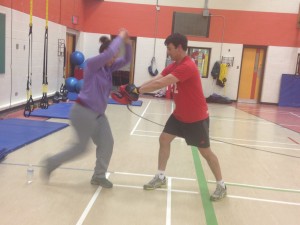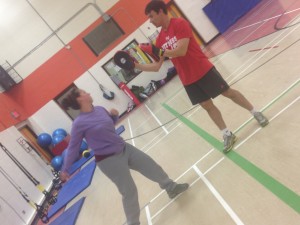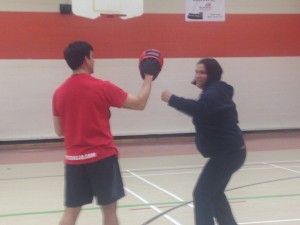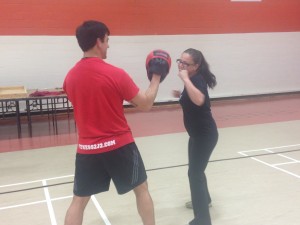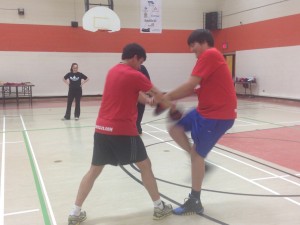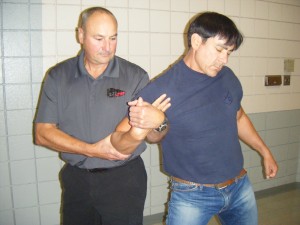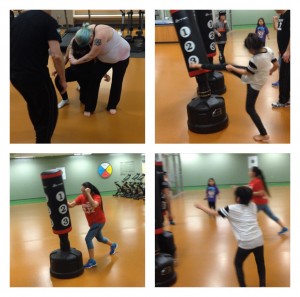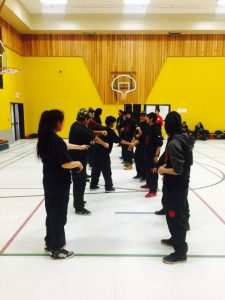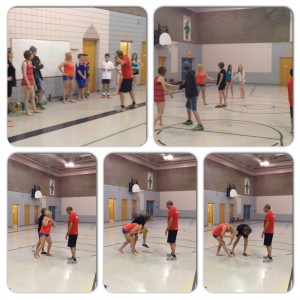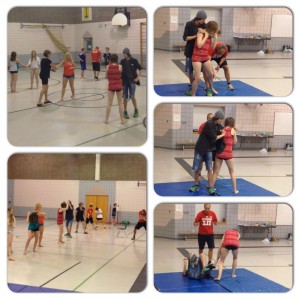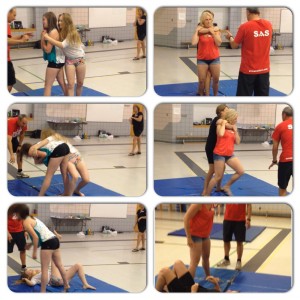Women’s and Youth Assault Prevention
Designed specifically for women and youth wanting a usable skill set, and a greater sense of control in dealing with the challenges faced in today’s world
Leon Durette, Albert Boucher, Joel Pedersen, Defensive Tactic Instructors can be reached at 306-281-5338 or email at jp@fitness2j2.com
BULLY DEFENCE BASICS
We believe the best defence you can have against a bully is to be truly confident that you are strong in mind, body, and spirit. A positive self-image will lessen the likelihood that you will be targeted by a bully in the first place. Using defensive tactics to protect you must always be a last resort. Here are some tips that may help you.
Bully Defence on the Bus
1: Sit near the front of the bus! Sitting close to the driver will make bullies and teasers think twice before acting for fear of getting caught.
2: Don’t stay silent! Unless you feel that another kid will physically attack you if you speak up, remaining completely silent while kids are harassing you will only encourage them to keep doing it. Try one of the following: Directly ask them to stop. Distract them by starting a conversation that might interest them.
3: Sit with friends! There is strength in numbers. You are less likely to be singled out if you are sitting with others.
Bully Defence at Lunch
1: Move your seat! Ask a friend to move with you. If you are assigned to a seat, ask an adult if you can change it. If he or she says no, tell your parents so they can talk to the person in charge to get your seat changed.
2: Sit close to an adult! Bullies don’t bully and teasers don’t tease around adults? So sit as close to one as you can! If an adult who is supervising doesn’t recognize the problem, please tell a teacher you trust or your parents.
3: Be the first one to enter the lunchroom and the first one to leave! Don’t waste time in the halls when going to lunch or when getting back to class after lunch. Wasting time only gives bullies more opportunity to bother you.
Bully Defence in the Halls
1: Always be aware of who is ahead of you! If you see a bully or teaser ahead of you, DON’T pass the person and give him or her opportunity to bother you by noticing that you are there! Take your time and slow down a little so they get further ahead of you.
2: Always be aware of who is behind you! Don’t allow a bully or teaser to stay directly behind you in the hall. He or she will most likely follow you until you have reached a part of the school with no teachers around in order to harass you without fear of being caught. If you notice a bully or teaser behind you, stop and let him or her pass. Stop in to say hello to a favourite teacher or go to the front office or the nurse’s office to say hello.
3: Go a different way when possible! If your school has a first and second floor you may have a choice of taking more than one way to class. Choose the safest way even if the safest one is the longest one. It is worth the longer walk to prevent giving the bully or teaser an opportunity to bother you.
Bully Defence Online
Tip 1: Don’t respond to the message! Although it is very tempting to tell a bully off, it is not a good idea. This may only get the bully angry and cause more problems for you. The bully also can print out your message and use it against you by showing it to teachers or to the principal to say you were the one who started the problem and not the other way around.
Tip 2: Get out of the chat room! If someone is making fun of you or is threatening you in a chat room, leave that room so the person doesn’t have the opportunity to continue. Take down the screen name and report the situation to your online provider.
Tip 3: Print out any threatening or harassing messages! You can’t prove it is happening if you do not print out the evidence. Show the printed message to your parents. It is against the law to threaten or harass someone online.
Tip 4: Report inappropriate messages to your parents and your online provider! Most online services will suspend individuals who violate online rules. Let the offender get what is coming and report the violation to get him or her off the net.
Bully Defence in General
1: Don’t exchange insults with bullies! This will only make the bully try harder to make you look bad in front of others.
2: Don’t accept getting teased to fit in with the popular group! Some kids tolerate teasing to try to be accepted by a popular group of kids. If you are hoping they will stop teasing you as soon as they get to know you, it most likely will not happen.
3: Immediately report the bullying or harassment! Many popular kids are very concerned about remaining popular, not only with their classmates but also with their teachers. Mention what is happening to a teacher or counsellor you trust. A student talking to an adult in this situation may be enough to stop the offending behaviour.
///////////////////////////////////////////////////////////////////////////////
Joel Pedersen | April 2015 | Eagle Feather News.
For the past few years I have been an Investigator with the Saskatoon Police Service in the section of Domestic Violence. My colleagues and I would review and investigate hundreds of incidents each year. From stalking and harassment, to domestic assault and attempted murder: none of these stories are the same, and it does not matter what part of the city they live in nor the jobs or professions they may have or positions they may hold. Domestic Violence may affect all of us either directly or indirectly.
Often what we find are unhealthy lifestyles, either alcohol and drug addictions; mental health related conditions; break down of relationships full of regret, remorse, and resentment. Most involve families, and if so, always the victims are the children. Often not even realizing the environment they are living in is not healthy, it is however their reality.
Many in abusive relationships may experience a cycle, or pattern of abuse. The cycle of abuse may speed up during the course of a relationship, and the calm stage may become shorter. As the cycle continues, the abuse will likely become more extreme.
There are many reasons people live with partners that are violent and abusive. Hope, love, and fear are three emotions that keep the cycle in motion and make it hard to ask for help or end an abusive relationship. Love for your partner, because the relationship has its good points? It’s not all that bad, it could be worse? Hope that it will change, because the relationship didn’t start like this? Fear of threats to harm you or your family will become a reality; financial; being ‘alone’.
The most recent homicide in Tisdale, Saskatchewan brings once again the seriousness of domestic violence. Domestic violence should not happen to anybody, ever, period. But it does, and when it does there is help. Maybe you have lived with abuse, maybe it happened just once; maybe you work or live next to someone who is being abused right now. Know your rights, it is a crime if someone physically hurts or threatens you. No one has the right to hurt you, physically or emotionally, even if they say they love you. In Canada, victims of Intimate Partner Violence are protected under the Criminal Code of Canada. The police can arrest the abuser if the incident involves: an assault; threats of violence; use of a weapon; destruction of your personal property; harassment or stalking; an abuser in violation of a no-contact order.
In Saskatchewan, the Victims of Domestic Violence Act provides police and prosecutors legal tools to assist victims of domestic violence, in addition to the Criminal Code of Canada.
Emergency Intervention Orders (EIO) are available 24 hours a day in emergent cases. Police, mobile crisis or victim assistance workers can help victims apply for an EIO. These orders are effective upon notice to the abuser, and remain in effect for as long as the Justice of the Peace directs. EIO can restrain the abuser from contacting with or communicating the victim or victim’s family. Provides the victim exclusive occupation of the home so they are not the one to leave, among other things.
Victim’s Assistance Order is very similar to the EIO except it deals with non-emergency situations. This can also order financial compensation from the abuser for losses suffered as a result of the domestic violence.
Domestic violence and emotional abuse are behaviors used by one person in a relationship to control the other. Although both men and women can be abused, most victims are women. Children in these homes know about the violence, even if a child is not physically harmed, they may have emotional and behavior problems as a result of being exposed to the behaviors and actions. If you are being abused, you are not alone. It is not your fault. Help is available.
Click here for more Health stories, Eagle Feather News. www.eaglefeathernews.com
Canadian statistics on violence against women and children
- Children make up 21% of the population and up to 75% of all sexual assault victims.
- There are an average of 15,000 confirmed cases of sexual abuse per year in Canada.
- There are an average of 48 stranger abductions per year in Canada.
- Half of Canadian women (51%) have been victims of at least one act of physical or sexual violence since the age of 16. Of all victims of crimes against the person in 2000, females made up the vast majority of victims of sexual assaults (86%), criminal harassment (78%) and kidnapping/hostage-taking or abduction (67%).
- Women are much more likely to be victimized by someone they know than by a stranger. In 2000, 77% of all female victims were victimized by someone they know (37% by a close friend or an acquaintance, 29% by a current or past partner, 11% by other family members – including parents) while 19% were victimized by a stranger.
(http://www.swc-cfc.gc.ca/dates/dec6/facts_e.html)
www.cdhpi.ca
www.pathssk.org

